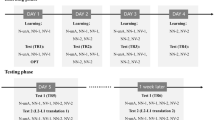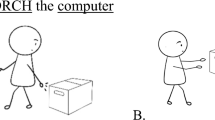Abstract
This study examines whether semantic relatedness facilitates or impedes the acquisition of English collocations by conducting two experiments respectively on Chinese undergraduates. Each experiment was composed of a reading session, a productive test, and a receptive test. Experiment 1 began with the reading session of 28 paired-up words and their collocations (in sentence context). Those words were counterbalanced between two randomly selected groups by cross-matching on semantic relatedness. Results of the productive test revealed that the participants scored significantly higher on test items that were semantically related than the randomly cross-paired counterparts. However, for the receptive test, the participants performed significantly better on semantically unrelated items. Experiment 2 was similar to Experiment 1 except that the word pairs selected were only semantically related and did not have any shared morphemes. Experiment 2 also revealed consistent results. The results of the two experiments consistently illustrate that semantic relatedness may exert a facilitatory effect on language output but an inhibitory effect on the process of language input.

Similar content being viewed by others

References
Abel, A. D., Maguire, M. J., Naqvi, F. M., & Kim, A. Y. (2015). Lexical retrieval of nouns and verbs in a sentence completion task. Journal of Psycholinguistic Research, 44(5), 545–553.
Aitchison, J. (1994). Words in the mind: An introduction to the mental lexicon (2nd ed.). Oxford: Blackwell Publishers Ltd.
Aitchison, J. (1996). Taming the wilderness: Words in the mental lexicon. In G. M. Anderman & M. A. Rogers (Eds.), Words, words, words: The translator and the language participant (pp. 15–26). Bristol: Multilingual Matters.
Anderson, J. R. (1983). The architecture of cognition. Cambridge, MA: Harvard University Press.
Anderson, M. C. (2003). Rethinking interference theory: Executive control and the mechanisms of forgetting. Journal of Memory and Language, 49(4), 415–445.
Bentin, S., & Feldman, L. (1990). The contribution of morphological and semantic relatedness to repetition priming at short and long lags: Evidence from Hebrew. The Quarterly Journal of Experimental Psychology, 42(4), 693–711.
Cheung, A. C. K., & Slavin, R. E. (2016). How methodological features affect effect sizes in education. Educational Researcher, 45(5), 283–292.
Cohen, J. (1988). Statistical power analysis for the behavioral sciences (2nd ed.). Hillsdale: Lawrence Erlbaum.
Colombo, L., Navarrete, E., & Arfé, B. (2017). Acquisition of nouns and verbs in Italian pre-school children. Journal of Child Language, 44(6), 1362–1393.
Damian, M. F., Vigliocco, G., & Levelt, W. J. M. (2001). Effects of semantic context in the naming of pictures and words. Cognition, 81, 77–86.
Diamanti, V., Mouzaki, A., Ralli, A., Antoniou, F., Papaioannou, S., & Protopapas, A. (2017). Preschool phonological and morphological awareness as longitudinal predictors of early reading and spelling development in Greek. Frontiers in Psychology, 8, 2039.
Erten, I. H., & Tekin, M. (2008). Effects on vocabulary acquisition of presenting new words in semantic sets versus semantically unrelated sets. System, 36(3), 407–422.
Finkbeiner, M., & Nicol, J. (2003). Semantic category effects in second language word learning. Applied Psycholinguistics, 24(3), 369–383.
Glass, G. V., McGaw, B., & Smith, M. L. (1981). Meta-analysis in social research. Beverly Hills: Sage.
Hashemi, R. H., & Gowdasiaei, F. (2005). An attribute-treatment interaction study: Lexical-set versus semantically unrelated vocabulary instruction. Regional Language Centre Journal, 36(3), 341–361.
Hong, W., & Feng, C. (2014). Facilitatory or inhibitory? The effect of semantic relatedness on L2 collocation learning. Modern Foreign Languages, 37(1), 96–106.
Horoufchin, H., Bzdok, D., Buccino, G., Borghi, A. M., & Binkofski, F. (2018). Action and object words are differentially anchored in the sensory motor system—A perspective on cognitive embodiment. Scientific Reports, 8, 6583.
Hoshino, Y. (2010). The categorical facilitation effects on L2 vocabulary learning in a classroom setting. Regional Language Centre Journal, 41(3), 301–312.
Ibarrola, A., & Gordo, M. A. (2015). Should EFL teachers present vocab semantically related sets? Porta Linguarum, 23, 25–40.
Kambanaros, M., Grohmann, K. K., & Michaelides, M. (2013). Lexical retrieval for nouns and verbs in typically developing bilectal children. First Language, 33(2), 182–199.
Levelt, W. J. M., Roelofs, A., & Meyer, A. S. (1999). A theory of lexical access in speech production. Behavioral and Brain Sciences, 22(1), 1–75.
Lin, Y. C., Chen, H. Y., Lai, Y. C., & Wu, D. H. (2015). Phonological similarity and orthographic similarity affect probed serial recall of Chinese characters. Memory & Cognition, 43(3), 538–554.
McBride-Chang, C., Wagner, R., Muse, A., Chow, B., & Shu, H. (2005). The role of morphological awareness in children’s vocabulary acquisition in English. Applied Psycholinguistics, 26(3), 415–435.
Nation, P. (2000). Learning vocabulary in lexical sets: Dangers and guidelines. TESOL Journal, 9(2), 6–10.
National College English Examination Board. (2016). Syllabus for college English test. Shanghai: Shanghai Jiaotong University Press.
Neely, J. H. (1977). Semantic priming and retrieval from lexical memory: The roles of inhibitionless spreading activation and limited-capacity attention. Journal of Experimental Psychology: General, 106(3), 226–254.
Papathanasiou, E. (2008). An investigation of two ways of presenting vocabulary. ELT Journal, 63(4), 313–322.
Posner, M. L., & Snyder, C. R. R. (1975a). Attention and cognitive control. In R. L. Solso (Ed.), Information processing and cognition: The Loyola symposium. Hillsdale, NJ: Erlbaum.
Posner, M. L., & Snyder, C. R. R. (1975b). Facilitation and inhibition in the processing of signals. In P. Rabbit & S. Domic (Eds.), Attention and performance V. New York: Academic Press.
Reed, S. K. (2004). Cognition: Theory and applications. Belmont, CA: Thomson Wadsworth.
Rosenthal, J. A. (1996). Qualitative descriptors of strength of association and effect size. Journal of Social Service Research, 21(4), 37–59.
Soloukhina, O. A., & Ivanova, M. V. (2017). Investigating comprehension of nouns and verbs: Is there a difference? Aphasiology, 32(2), 183–203.
Stamer, M., & Vitevitch, M. (2012). Phonological similarity influences word learning in adults learning Spanish as a foreign language. Bilingualism: Language and Cognition, 15(3), 490–502.
Stoller, F., & Grabe, W. (1995). Implications for L2 vocabulary acquisition and instruction from L1 vocabulary research. In T. Huckin, M. Haynes, & J. Coady (Eds.), Second language reading and vocabulary learning (pp. 24–45). Norwood, NJ: Ablex Publishing Corporation.
Tinkham, T. (1993). The effect of semantic clustering on the learning of second language vocabulary. System, 21(3), 371–380.
Tinkham, T. (1997). The effects of semantic and thematic clustering on the learning of a second language vocabulary. Second Language Research, 13(2), 138–163.
Waring, R. (1997). The negative effects of learning words in semantic sets: A replication. System, 25(2), 261–274.
Wilcox, A., & Medina, A. (2013). Effects of semantic and phonological clustering on L2 vocabulary acquisition among novice participants. System, 41(4), 1056–1069.
Xia, Q., Wang, L., & Peng, G. (2016). Nouns and verbs in Chinese are processed differently: Evidence from an ERP study on monosyllabic and disyllabic word processing. Journal of Neurolinguistics, 40, 66–78.
Yu, X., Bi, Y., Han, Z., & Law, S.-P. (2013). An fMRI study of grammatical morpheme processing associated with nouns and verbs in Chinese. PLoS ONE, 8(10), e74952.
Yurchenko, A., Golovteev, A., Kopachev, D., & Dragoy, O. (2017). Comprehension and production of nouns and verbs in temporal lobe epilepsy. Epilepsy & Behavior, 75, 127–133.
Zhang, L., & Sheng, Y. (2009). A Study of the influence of semantically-relatedness of word-sets on L2 vocabulary acquisition. Foreign Language Learning Theory and Practice,4, 18–23.
Acknowledgements
Our special thanks go to Prof. Li Yang and Prof. Zhang Juan for their help in data collection.
Funding
The authors received no financial support for the research, authorship, and/or publication of this article.
Author information
Authors and Affiliations
Corresponding author
Ethics declarations
Conflict of interest
The authors declared no potential conflicts of interest with respect to the research, authorship, and/or publication of this article.
Rights and permissions
About this article
Cite this article
Jiang, Mc., Jong, My., Tse, Cs. et al. Examining the Effect of Semantic Relatedness on the Acquisition of English Collocations. J Psycholinguist Res 49, 199–222 (2020). https://doi.org/10.1007/s10936-019-09680-9
Published:
Issue Date:
DOI: https://doi.org/10.1007/s10936-019-09680-9



